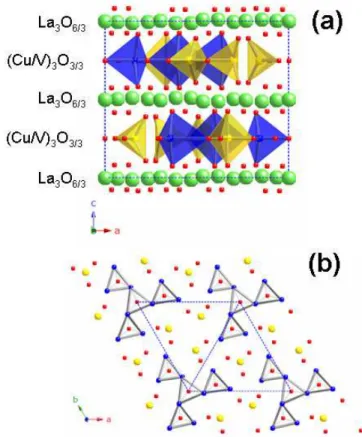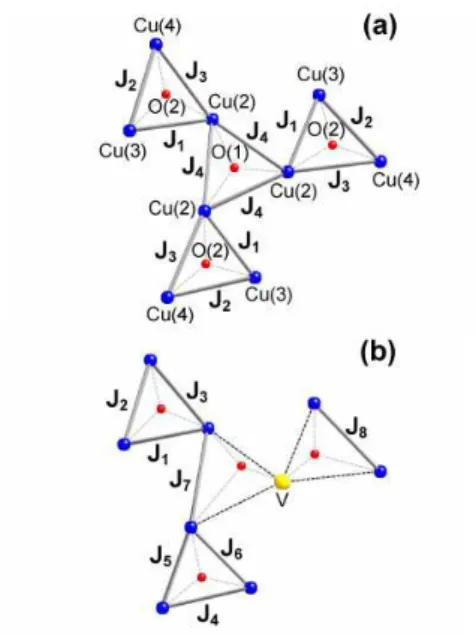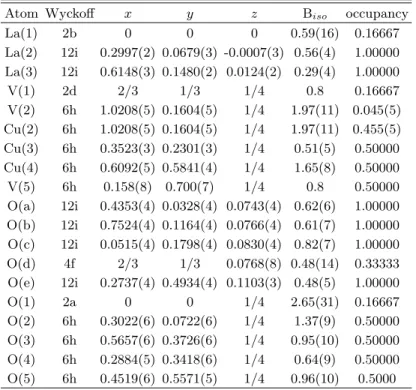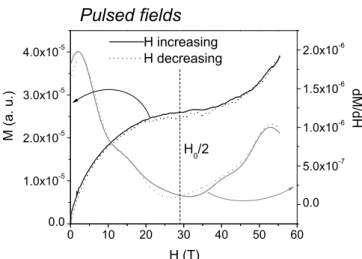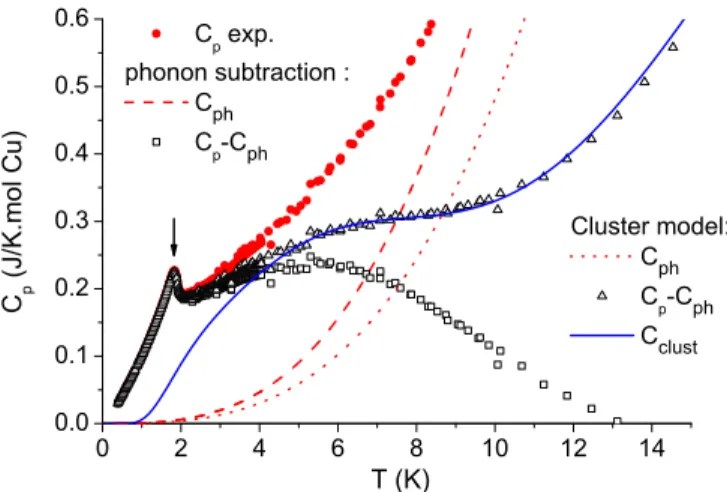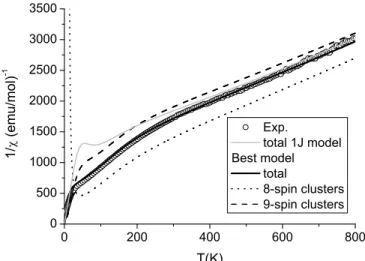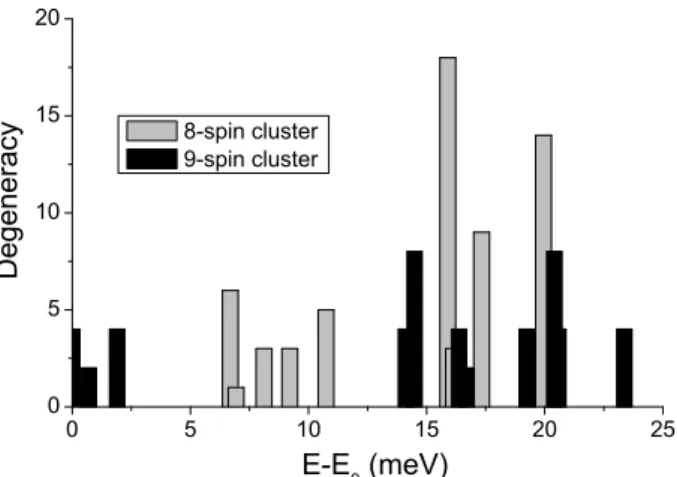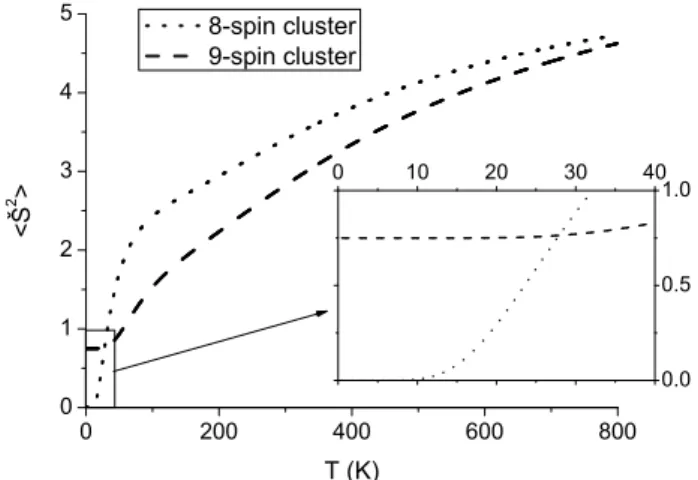HAL Id: hal-00179669
https://hal.archives-ouvertes.fr/hal-00179669v2
Submitted on 13 Aug 2008
HAL is a multi-disciplinary open access
archive for the deposit and dissemination of
sci-entific research documents, whether they are
pub-lished or not. The documents may come from
teaching and research institutions in France or
abroad, or from public or private research centers.
L’archive ouverte pluridisciplinaire HAL, est
destinée au dépôt et à la diffusion de documents
scientifiques de niveau recherche, publiés ou non,
émanant des établissements d’enseignement et de
recherche français ou étrangers, des laboratoires
publics ou privés.
Julien Robert, Virginie Simonet, Benjamin Canals, Rafik Ballou, Elsa Lhotel,
Céline Darie, Pierre Bordet, Bachir Ouladdiaf, Marc Johnson, Jacques
Ollivier, et al.
To cite this version:
Julien Robert, Virginie Simonet, Benjamin Canals, Rafik Ballou, Elsa Lhotel, et al.. Formation of
collective spins in frustrated clusters. Physical Review B: Condensed Matter and Materials Physics
(1998-2015), American Physical Society, 2008, 77, pp.054421. �10.1103/PhysRevB.77.054421�.
�hal-00179669v2�
Formation of collective spins in frustrated clusters
J. Robert,1 V. Simonet,1 B. Canals,1 R. Ballou,1 E. Lhotel,1 C. Darie,1 P. Bordet,1 B.
Ouladdiaf,2 M. Johnson,2 J. Ollivier,2 D. Braithwaite,3 H. Rakoto,4 and S. de Brion5
1Institut NEEL, CNRS & Universit´e Joseph Fourier, BP 166, F-38042 Grenoble Cedex 9, France 2Institut Laue-Langevin, BP 154, F-38042 Grenoble Cedex, France.
3CEA-Grenoble, DRFMC/SPSMS/IMAPEC, 17 rue des Martyrs, F-38054 Grenoble cedex, France 4Laboratoire National des Champs Magn´etiques Puls´es,
143 avenue de Rangueil, F-31400 Toulouse, France
5Grenoble High Magnetic Field Laboratory, CNRS, BP 166, F-38042 Grenoble, France
(Dated: August 13, 2008)
Using magnetization, specific heat and neutron scattering measurements, as well as exact calcula-tions on realistic models, the magnetic properties of the La3Cu2VO9compound are characterized on
a wide temperature range. At high temperature, this oxide is well described by strongly correlated atomic S=1/2 spins while decreasing the temperature it switches to a set of weakly interacting and randomly distributed entangled pseudo spins ˜S = 1/2 and ˜S = 0. These pseudo-spins are built over frustrated clusters, similar to the kagom´e building block, at the vertices of a triangular superlattice, the geometrical frustration intervening then at different scales.
I. INTRODUCTION
A lot of work has been devoted recently to the under-standing of the peculiar magnetic behaviour of extended networks of spins on triangle or tetrahedron based lat-tices. These elemental configurations of spins, especially when they are corner-sharing, imply strong geometrical frustration for antiferromagnetically coupled Heisenberg spins, i.e. inability to simultaneously minimize the pair interactions. The case of S=1/2 spins is especially ap-pealing because it should enhance quantum physical be-haviour. The archetypical frustrated network of spins in 2 dimensions is the kagom´e lattice, which is expected to stabilize, at low temperature, a spin liquid state [1]. One of the most striking feature of this state is the presence of many low lying singlet states [2]. This feature could be interpreted in a short-range resonating valence bond picture of the kagom´e ground state [3]. Few experimental realizations of kagom´e lattice with S=1/2 spins are avail-able. Among these, the recently studied hebertsmithite [4] does not present any magnetic transition down to the lowest temperature but its fluctuating ground state is still under debate since it does not meet the theoreti-cal predictions [2, 4, 5, 6]. The theoretitheoreti-cal studies have been undertaken on ideal systems but exact solutions can only be obtained for a limited number of spins (up to 36) [2, 7]. This is one of the reasons why it should be inter-esting to study experimentally a system constituted of isolated frustrated clusters of spins, for which the exact calculations are fully relevant.
The physics of spin clusters has attracted much atten-tion by itself. Quantum dynamics of mesoscopic magnets and decoherence effects by specific environments for in-stance can be investigated in organo-metallic molecular magnets with metal clusters stabilizing a collective spin magnetically isolated by the organic ligands. A number of investigations thus followed the discovery of a stair-case magnetization hysteresis loop associated with the
quantum tunneling of collective spins trough a magnetic
anisotropy energy barrier [8, 9]. Clusters with small
total spin and large N´eel vector also raised strong in-terest. This is the case of the polyoxovanadate,
short-named V15, constituted of 15 V4+ ions. Its magnetic
properties, showing quantum processes under sweeping field [10], are accounted for by the formation of a
collec-tive pseudo-spin ˜S=1/2 from the three weakly coupled
S=1/2 spins on the central triangle of the cluster [11]. The study of spin clusters within oxide compounds was undertaken more recently. At variance with molecular compounds, the magnetic screening then is much less ef-fective, which leads to non-negligible cluster inter-actions and therefore allows the study of the coupling of the collective entities. For instance, in the oxide
com-pound La4Cu3MoO12, a trimer of S=1/2 spins is
stabi-lized in each triangle of Cu2+ at the vertices of a square
lattice [12, 13, 14, 15]. The inter-cluster couplings in
La4Cu3MoO12 is two orders of magnitude smaller than
the intra-cluster ones, and lead to the onset of an
antifer-romagnetic long-range order at 2.6 K. In both V15 and
La4Cu3MoO12 compounds, the splitting of the 2
funda-mental S=1/2 spins doublets might be attributed to a departure from the trigonal symmetry. A last remark-able oxide compound whose properties are dominated by
spin clusters is Na2V3O7 [16, 17, 18, 19]. The clusters
are built on rings of 9 antiferromagnetically interacting
V4+ ions of S=1/2 spins, piled up in tubes with
inter-ring ferromagnetic interactions. One S=1/2 spin out of 9 is left active in the low temperature paramagnetic regime through a dimerization process of the other spins of the ring, characterized by a broad range of V-V interactions. The proximity of a quantum critical point at H=0 is sug-gested from the complex magnetic behaviour observed with respect to the magnetic field H at low temperature T.
The layered oxide La3Cu2VO9 [20, 21], parent of the
in-tersection of geometrical frustration and spin cluster
re-search areas. In the magnetic layers, the Cu2+ ions form
planar clusters of antiferromagnetically coupled 8 and 9 S=1/2 spins, arranged on 4 corner-sharing triangles. The geometrically frustrated 9-spin cluster is very simi-lar to the building block of a kagom´e network. As will be shown in the following, a collective state of spin is con-structed from the S=1/2 spins wave functions of each cluster while decreasing the temperature. The result-ing collective pseudo-spins involve a greater number of
individual spins than in the V15 or La4Cu3MoO12
com-pounds. Like in La4Cu3MoO12, the inter-cluster
cou-plings in La3Cu2VO9are two orders of magnitude smaller
than the intra-cluster ones, and their influence is trace-able in the experimental low temperature range. More-over, the clusters themselves are arranged on a triangular lattice, which gives the opportunity to study the influence of geometrical frustration at different spatial and energy scales in the same compound.
In this article, following a preliminary report [22], we will focus on the individual behavior of these pseudo-spins, their interplay when inter-cluster interactions be-come effective will be the subject of a forthcoming paper
[23]. The synthesis and crystallography of La3Cu2VO9
polycrystalline sample will first be described, with special emphasis on the Cu/V substitution. Then, the magnetic measurements will be presented, in a wide temperature range, following the construction of the collective pseudo-spin, and also in high magnetic fields. The next two sec-tions will respectively present the results of specific heat measurements and of inelastic neutron scattering. The last section before concluding will be devoted to a dis-cussion of these experimental results in the light of exact calculations performed on realistic models of spins clus-ter.
II. EXPERIMENTAL
A. La3Cu2VO9 sample characterization
1. Synthesis and structure
A polycrystalline La3Cu2VO9 sample was synthesized
by a sol-gel method. The stoichiometric metallic cations were dissolved in nitric acid before being complexed by addition of EDTA in a controlled pH solution. This
so-lution was polymerized and then heated at 700 ◦ C to
eliminate the organic constituents. The resulting powder
was annealed during 15 days at 1010◦C. The sample was
first checked to be a single phase using X-ray diffraction. Neutron powder diffractograms were then recorded on the high resolution powder diffractometer D2B at the
In-stitut Laue Langevin with a wavelength of 1.59 ˚A using
a Ge monochromator (cf. Fig. 2). The absence of struc-tural phase transition was checked from 3 to 300 K. The crystallographic description of the sample, obtained from the Rietvelt analysis of the neutron diffractograms with
FIG. 1: (Color online) (a) La3Cu2VO9 structure projected
along the b axis: LaO6/3layers alternating with (Cu/V)O3/3
ones with the O polyhedron drawn around Cu and V atoms. (b) La3Cu2VO9 structure projected along the c axis:
(Cu/V)O3/3layers showing the 9 Cu2+clusters at the vertices
of a triangular lattice. La, V, Cu and O atoms are represented by large green, yellow, blue and small red circles, respectively.
the Fullprof program [24], was found consistent with the
results of Ref. [21]: the La3Cu2VO9 oxide compound
crystallizes in the hexagonal P63/m space group with
lattice parameters a=b=14.395(2) ˚A, c=10.656(2) ˚A at
300 K. As shown in Fig. 1 (a), LaO6/3 layers alternate
with (Cu/V)O3/3 layers underlying the 2D structure of
the compound. In these, the Cu2+ ions, the only
mag-netic ones with a S=1/2 spin, are localized on three in-equivalent sites Cu(2), Cu(3) and Cu(4) (following the site labeling of ref. 21) having different coordination en-vironments. These are forming 9-spin planar clusters, constituted with 4 corner-sharing triangles. The clusters are centered at the vertices of a 2D triangular lattice (cf. Fig. 1 (b)). Within the planes, O-coordinated V atoms are intercalated between the clusters.
A Cu/V substitution, of vanadium V5+ ions for
cop-per Cu2+ ions, dictated by the global charge neutrality
requirement that fixes the stoichiometric proportions of
the different ions, occurs in the very small ratio of 271.
Notice nevertheless that this in average corresponds to
one Cu/V substitution over 13 of the 9-spin planar
clus-ters. We will detail the nature and consequence of this substitution below.
3 20 40 60 80 100 120 140 -5000 0 5000 10000 15000 Exp. Calc. Difference I n t e n si t y ( a . u . ) 2 (°) T=3 K
FIG. 2: La3Cu2VO9 powder neutron diffractogramm
recorded at 3 K on D2B, the corresponding refined pattern and their difference. The refined structural parameters are presented in table I.
In non substituted clusters, the neighbor Cu-Cu
dis-tances within the cluster range between 3.35 ˚A and 3.8
˚
A, whereas the shortest in-plane distances between the peripheral Cu of the neighboring clusters is larger and
equal to 4.55 ˚A. In comparison, the distance between
two adjacent (Cu/V)O3/3 layers is 5.3 ˚A.
Within the (Cu/V)O3/3 layers, the first neighbor
S=1/2 spins of each cluster are interacting through su-perexchange via an intermediate O. Concerning the inter-cluster magnetic interaction within one layer or between adjacent layers, possible longer superexchange paths can be effective through one or two O.
2. Cu/V Substitution
In order to understand the magnetic properties of the compound, it was found essential to take into account the Cu/V substitution and the related modifications of the cluster structure.
To get insight into the distribution of the V in the clus-ters, refinement of the powder neutron diffraction data at 3 K was made allowing V substitution on each cop-per sites, alternatively. Although the fit is slightly better when the Cu(2) site (central triangle) is substituted in-stead of Cu(3) and Cu(4) sites, in agreement with previ-ous results [21] (see Table I and Fig. 2), further analysis was estimated necessary to unambiguously characterize the Cu/V substitution.
Using the VASP package [25], Density functional the-ory (DFT) methods applied to electronic structure calcu-lation, based on the local-density approximation (LDA) and Projector Augmented Wave (PAW) method, were used for this purpose. The DFT calculations were per-formed with periodic boundary conditions on one unit cell containing 130 atoms and including 2 clusters located
in the two (Cu/V)O3/3 layers at z=1/4 and z=3/4.
The non substituted (and hence non stoichiometric)
FIG. 3: (Color online) DFT calculated positions of the Cu (blue circles), V (large yellow circles), and O (small red cir-cles) atoms in the 9-spin clusters (a) and 8-spin clusters (b). The labeling of the different superexchange interactions is used in section III A.
structure was first optimized, and found very close to the one determined from powder neutron diffraction. Differ-ent calculations were then performed replacing, in the optimized structure, one Cu by a V, alternatively on each Cu(2), Cu(3) and Cu(4) site of the cluster. The large energy difference between these calculated struc-tures first confirmed the localization of the substitution
on the Cu(2) sites : ECu(3)≃ ECu(4) > ECu(2) by ∼ 2 eV,
with ECu(i) the energy of the structure with the Cu/V
substitution on the Cu(i) site.
In addition, the calculated structure reveals large de-formations around the V substitute. The two first neigh-bor O of the V get closer to it and further away from the neighboring Cu (cf. Fig. 3). A consequence of this is the
apparent greater isotropic displacement parameter Biso
of the neighboring oxygen on site O(1) in the Rietveld analysis of the neutron diffractogramms (see Table I).
Calculations with two V/Cu substitutions on the same cluster were finally carried out and compared to those with only one substitution. The obtained energy differ-ence between these two structures, of the order of 1 eV, is in favor of only 1 Cu/V substitution per cluster. The resulting reasonable assumption of a negligible number of 7 (or less) Cu clusters therefore leads to a microscopic population of 2/3 of 9-Cu clusters and 1/3 of 8-Cu/1-V clusters.
TABLE I: Refined structural parameters from Rietveld analysis of neutron powder diffraction data of La3Cu2VO9at 3 K. Biso
is the isotropic displacement parameter in ˚A2
. The agreement factors are 3.38 for the Bragg R-factor and 2.27 for the Rf-Bragg factor.
Atom Wyckoff x y z Biso occupancy
La(1) 2b 0 0 0 0.59(16) 0.16667 La(2) 12i 0.2997(2) 0.0679(3) -0.0007(3) 0.56(4) 1.00000 La(3) 12i 0.6148(3) 0.1480(2) 0.0124(2) 0.29(4) 1.00000 V(1) 2d 2/3 1/3 1/4 0.8 0.16667 V(2) 6h 1.0208(5) 0.1604(5) 1/4 1.97(11) 0.045(5) Cu(2) 6h 1.0208(5) 0.1604(5) 1/4 1.97(11) 0.455(5) Cu(3) 6h 0.3523(3) 0.2301(3) 1/4 0.51(5) 0.50000 Cu(4) 6h 0.6092(5) 0.5841(4) 1/4 1.65(8) 0.50000 V(5) 6h 0.158(8) 0.700(7) 1/4 0.8 0.50000 O(a) 12i 0.4353(4) 0.0328(4) 0.0743(4) 0.62(6) 1.00000 O(b) 12i 0.7524(4) 0.1164(4) 0.0766(4) 0.61(7) 1.00000 O(c) 12i 0.0515(4) 0.1798(4) 0.0830(4) 0.82(7) 1.00000 O(d) 4f 2/3 1/3 0.0768(8) 0.48(14) 0.33333 O(e) 12i 0.2737(4) 0.4934(4) 0.1103(3) 0.48(5) 1.00000 O(1) 2a 0 0 1/4 2.65(31) 0.16667 O(2) 6h 0.3022(6) 0.0722(6) 1/4 1.37(9) 0.50000 O(3) 6h 0.5657(6) 0.3726(6) 1/4 0.95(10) 0.50000 O(4) 6h 0.2884(5) 0.3418(6) 1/4 0.64(9) 0.50000 O(5) 6h 0.4519(6) 0.5571(5) 1/4 0.96(10) 0.5000 0 100 200 300 400 500 600 700 800 0.00 0.02 0.04 0.06 0.08 0 2 4 6 8 10 0.00 0.02 0.04 0.06 0.08 0.10 0.12 ( e m u /m o l.c lu s te r ) T (K)
FIG. 4: La3Cu2VO9 magnetic susceptibility from M/H
mea-surements: in the high temperature range at 6 T using the BS magnetometer and at 0.1 T using the Quantum Design MPMS magnetometer; in the low temperature range using the purpose built SQUID magnetometer in 0.01, 0.1, 0.2 T (open circles), in good agreement with the higher tempera-tures measurements (plain circles). A discontinuity around 2 K is pointed out by the vertical line.
B. Magnetic properties
1. Magnetic susceptibility
Magnetization measurements were performed at the Institut Neel, on two purpose built magnetometers (BS) using the axial extraction method in the temperature range from 1.6 K to 800 K and magnetic field up to 10 T and on a more sensitive commercial Quantum De-sign SQUID magnetometer (MPMS) in the temperature range 2-350 K and magnetic field up to 5 T. Additional measurements at lower temperatures, from 0.23 K to 4 K, using a dilution inserted device were obtained on another purpose built highly sensitive SQUID magnetometer.
The thermal variation of the initial magnetic suscepti-bility χ is displayed in Fig. 4. χ was deduced from the M vs. H measurements in small magnetic fields such that the isothermal magnetization M varies linearly with the magnetic field H. An anomaly is observed around 2 K. The next section is devoted to the analysis of the suscep-tibility in the paramagnetic regime above the anomaly, the nature of the phase below it will be the subject of another publication [23].
The inverse χ−1 of the initial magnetic susceptibility,
shown in Fig. 5, has a peculiar shape, where three dis-tinct regions, with different (almost) linear slopes at low (I), intermediate (II), and high (III) temperatures, can be distinguished. In a first analysis following ref. [21], re-gions (I) and (III) were assumed to correspond to two dis-tinct paramagnetic regimes of interacting magnetic
enti-5
FIG. 5: La3Cu2VO9 inverse linear magnetic susceptibility
measured in 0.1 T and 6 T below and above 350 K respectively (open circles). Three regions of distinct magnetic behaviours are materialized in grey. A low temperature zoom is shown in the inset. The straight lines in regions I and III are calculated in a Curie-Weiss model (see text).
ties accounted for, in the mean field approximation, by a Curie-Weiss law χ = C/(T −θ) with the Curie-Weiss
tem-perature θ. The Curie constant, C = ng2µ
BS(S+1)/3kB
with the Land´e factor g=2, is evaluated for 1/3 of 8-spin
cluster + 2/3 of 9-spin clusters, i.e. 8.667 Cu2+; n is
therefore the number of S=1/2 spins per cluster. The resulting Curie-Weiss analysis are shown in Fig. 5 and the numerical values are reported in Table II: n, θ, the
effective moment µef f = gpS(S + 1), and the
temper-ature range of the best fits corresponding to the linear portion of regions (I) and (III). The slope of the high temperature region (III) is well described above 500 K with a Curie-Weiss fit using the expected value n of 8.667 S=1/2 spins per cluster in the paramagnetic regime (Fig. 5). The resulting large negative Curie-Weiss temperature for this regime, θ = −294 K, denotes strong intra-cluster antiferromagnetic couplings between these spins.
In the low temperature region (I), it is more difficult to isolate a linear regime in 1/χ, which rather presents a continuous curvature (Fig. 4). A forced Curie-Weiss fit in a reduced temperature range yields approximately one S=1/2 spin per cluster. The reduction of the Curie constant, by a factor close to 9, suggests that the mag-netic entities in the low temperature range are collective
˜
S=1/2 pseudo-spins, resulting from the entanglement of the wave functions of the paramagnetic spins within each cluster at high temperature. These pseudo-spins seem to be weakly antiferromagnetically coupled to each other since θ = −4.2 K in this region, which is about two orders of magnitude weaker than the θ value of region (III) corresponding to the intra-cluster coupling. This value, close to the one at which the susceptibility presents an anomaly, suggests that this last feature is related to the inter-cluster coupling which becomes effective at this temperature (cf. section II B 1). We will come back to
0 10 20 30 40 50 60 0.0 1.0x10 -5 2.0x10 -5 3.0x10 -5 4.0x10 -5 H (T) M ( a . u . ) H increasing H decreasing H 0 /2 0.0 5.0x10 -7 1.0x10 -6 1.5x10 -6 2.0x10 -6 d M / d H Pulsed fields
FIG. 6: Magnetization isotherm measured around T=1.4 K in increasing and decreasing pulsed field up to 55 T, and its field derivative. The dotted line indicates the middle of the magnetization plateau, which is related to the Zeeman cross-ing of the two first levels of the system with ∆S=+1 (see inset of Fig. 7).
.
FIG. 7: High field magnetization isotherms in meaningful units, measured by extraction at 3 K , and compared to the BS magnetization measurements. The solid and dotted hor-izontal lines point out the calculated saturation value of the ground state and of the first excited state magnetizations (see section III). The Zeeman diagram corresponding to the field-induced crossing of these two levels is shown in the inset.
.
the analysis of the low temperature regime in section III using a more detailed description of the clusters.
Concerning the intermediate temperature region (II), although 1/χ could also be believed to vary linearly from 40 to 200 K [21], a Curie-Weiss analysis does not have any physical meaning since no collective magnetic entities are formed, as will be shown in the theoretical analysis of section III.
Region T range (K) θ (K) µef f (µB) n
I 2-11 −4.2 ± 1.1 1.732 1.02 ± 0.19 III 500-850 −294 ± 73 1.732 8.667 TABLE II: Curie-Weiss parameters of the best fits accounting for the inverse susceptibility in the two quasi-linear regimes at low and high temperature. In the high temperature region, the number of spins S=1/2 per cluster was hold constant and equal to its expected value of 8.667.
2. High field magnetization
High field magnetization measurements were per-formed using pulsed fields at the Laboratoire National des Champs Magn´etiques Puls´es (Toulouse). The pulsed field, which can reach 55 T, is produced by the discharge of a capacitor bank into a resistive copper coil. The signal in the presence of the sample is proportional to the time derivative of its magnetization. The M vs H curve obtained at T ≈ 1.4 K is displayed in Fig. 6. It shows a saturation plateau centered on the inflexion
point H0/2 ≈ 29 T, indicated by the minimum in the
magnetization field derivative. Note that the influence of the weak inter-cluster interactions should be irrelevant at such high magnetic fields. An upturn of the magneti-zation occurs at higher magnetic fields, suggesting that
the plateau should end at about H0 = 58 T. This is
attributed to a Zeeman crossing of the first excited mag-netic energy levels with the ground level of the cluster system (cf. inset of Fig. 7). The quantitative analysis of this crossing will be further discussed in section III.
Since the pulsed field technique does not allow abso-lute measurements with a good accuracy, complementary measurements at 3 K were performed at the Grenoble High Magnetic Field Laboratory (GHMFL) on a magne-tometer using the axial extraction under a magnetic field up to 23 T produced by a 10 MW resistive magnet. An absolute calibration was performed using a Ni sample. The resulting curves presented in Fig. 7, in agreement with the BS lower fields measurements, show a tendency
to saturate at a value close to 0.67 µB/cluster, the
ex-pected value for antiferromagnetic 8- and 9-spin clusters in the (1/3)/(2/3) ratio (cf. section III).
3. Specific heat
Specific heat Cpin zero magnetic field was measured at
the CEA-Grenoble on a commercial calorimeter (Quan-tum Design PPMS) using the pulsed relaxation method
and equipped with an3He refrigerator allowing to reach
400 mK. Its low temperature behavior is shown in Fig. 8. An anomaly is clearly visible at 1.82 K, coinciding with the one observed in the initial magnetic suscepti-bility χ. In the absence of a non-magnetic isostructural compound, a determination of the magnetic part of the specific heat in the full temperature range is difficult.
0 2 4 6 8 10 12 14 0.0 0.1 0.2 0.3 0.4 0.5 0.6 T (K) Cluster model: C ph C p -C ph C clust C p ( J / K . m o l C u ) C p exp. phonon subtraction : C ph C p -C ph
FIG. 8: (Color online) Specific heat measurements at low tem-perature (circles) analyzed with two models: (i) The phonon contribution (dashed line) is obtained from a fit of Cp/T as
a function of T2
using the low temperature approximation Cp= β1T3+ β2T5in the range [12-28 K]. The resulting
mag-netic signal is represented with square symbols. (ii) The sec-ond model is based on the multi-J spin cluster description reported in table III of section III. The lattice contribution of the form Cp= β1T
3
+ β2T 5
(dotted lines) is adjusted such that the remaining signal (triangles) coincides with the cal-culated magnetic specific heat (solid line) above 5 K.
However, the lattice contribution is often evaluated by
a fit of Cp/T versus T2 in a temperature range where
it is assumed that the magnetic signal is negligible and that the following low temperature approximation for the
phonon contribution is valid: Cp = β1T3+ β2T5 with
β1= 12π
4
5 N kB/Θ 3
D where ΘD is the Debye temperature
and N is the number of vibrating ions. In the present case, the best fit in the 12-28 K temperature range yields
the values: β1 = (7.3 ± 0.09)10−4, as from which we
get ΘD ≈ 271 K, and β2 = (−2.3 ± 0.1)10−7. The
as-sumed magnetic part of the specific heat, remaining after subtraction of this contribution, presents a broad signal centered around 6 K, as shown in Fig. 8. This signal is interpreted as the signature of a Schottky anomaly due to the presence of discrete low energy levels associated to the spin clusters. This analysis will be deepened using the finer description of the pseudo-spins obtained from the calculation discussed in section III.
4. Inelastic neutron scattering
In order to probe the energy spectrum of the assembly
of collective spins in La3Cu2VO9, inelastic neutron
scat-tering measurements were performed on the IN4 time-of-flight spectrometer at the Institut-Laue-Langevin with an incident neutron beam of energy 16.9 meV (i.e. of
wavelength λ=2.2 ˚A), and an energy resolution of 0.77
7 contribution and the detector efficiency was calibrated
using a vanadium sample.
The energy response recorded at 2, 150 and 300 K integrated over the small momentum transfer Q, more
precisely in the range [0.1, 2] ˚A−1, where the magnetic
scattering is expected to be the largest are displayed in Fig. 9. As apparent from the increase of the sig-nal with increasing temperature and with increasing Q, there is an important contribution from the scattering by the phonons in the investigated energy range (up to 15 meV on the neutron loss energy side). A way of remov-ing it is to substract the spectrum at high temperature
TH=300 K renormalized by the appropriate thermal
fac-tor (1−exp(−khω¯
BTL))/(1−exp(−
¯ hω
kBTH)) from the spectra
at lower temperatures TL. This treatment might
under-estimate the magnetic contribution since magnetic signal arising from transitions between energy levels can still be present at high temperature, especially if the energy spectrum of the system is dense and extended in energy. This analysis allowed nevertheless to visualize in the cor-rected spectra a broad bump around 8.7 meV at 2 K , which largely decreases at 150 K. The magnetic origin of this feature was confirmed by its slow decrease with
increasing Q from 1 to 4 ˚A−1, once corrected from the
phonons. An additional signal at 2 K seems to be present in the foot of the elastic peak. The nature of this signal is hard to establish from this sole measurement since it could as well be quasielastic or inelastic with an energy gap of the order of the energy resolution.
III. ANALYSIS AND DISCUSSION
The crystallographic study established that each
La3Cu2VO9 plane can be described as a triangular
lat-tice of randomly distributed 1/3 of 8-spin and 2/3 of 9-spin clusters with antiferromagnetically interacting lo-calized S=1/2 spins on each Cu. The magnetic
proper-ties of La3Cu2VO9 in the range of temperature T >∼ 2
K should be dominated by a physics of isolated clusters, since the inter-cluster interactions are two orders of mag-nitude smaller than the intra-cluster ones. In the follow-ing, we shall probe this regime through calculations by exact diagonalization of 8-spin and 9-spin clusters model. The intra-cluster interactions parameterizing these calcu-lations will be adjusted from comparison with the exper-imental results. These impose the following constraints: first, the calculation should reproduce the measured ther-mal variation of the initial magnetic susceptibility and the magnetization processes in high magnetic field, in-cluding the saturation plateau and the Zeeman crossing at the largest available magnetic field. Second, the cal-culated energy spectrum of the system should account for the energy excitations revealed by inelastic neutron scattering and the magnetic specific heat. The nature of the resulting pseudo-spin state at low temperature will then be discussed. -10 0 10 0.0000 0.0005 0.0010 -10 0 10 0.0000 0.0005 0.0010 N e u t r o n co u n t s ( a . u . ) 2 K 150 K 300 K N e u t r o n co u n t s ( a . u . ) E (meV) with phonons correction 2 K 150 K E=8.7 meV IN4, =2.2 Å 0.1<Q<2Å -1
FIG. 9: (Color online) Inelastic neutron scattering measure-ments. Upper frame: Energy spectra at 2, 150 and 300 K, integrated on the Q interval [0.1, 2] ˚A−1. Lower frame: 2 and
150 K spectra corrected from the phonon contribution using the 300 K spectrum (see text).
0 200 400 600 800 0 500 1000 1500 2000 2500 3000 3500 Exp. total 1J model Best model total 8-spin clusters 9-spin clusters 1 / ( e m u /m o l) -1 T(K)
FIG. 10: Comparison of the inverse of the measured suscep-tibility (circles) with calculated ones (line) from a single J model (grey) and from the multi-J model of table III taking into account 8-spin (dotted) and 9-spin clusters (dashed).
A. Cluster calculation versus experiments
The calculation of the La3Cu2VO9magnetic properties
are obtained through exact diagonalisation of the Hamil-tonian of the model system where each 8-spin and 9-spin
0 10 20 30 40 50 0.0 0.2 0.4 0.6 0.8 1.0 1.2 M ( B / c l u s t e r s ) H (T) 9-spin cluster 8-spin cluster total 0.00 0.02 0.04 0.06 0.08 0.10 d M / d H min=28.8 T
FIG. 11: Calculated total M(H) in the multi-J model of table III, with the 8-spin (dotted) and 9-spin (dashed) contribu-tions, at 5 K. The grey line is the field derivative of the total M(H).
cluster is described by the Heisenberg Hamiltonien
H = −X
hiji
JijSi· Sj (1)
where the Jij < 0, labeled in Fig. 3, stand for all
near-est neighbor antiferromagnetic interactions between the spins i and j of the cluster (Fig. 3). In a single-J model
assuming that all Jij = J = −445 K, the ground states of
the 9- and 8-spin clusters are found to be associated with
a total spin ˜S=1/2 and ˜S=0, respectively. This yields in
average 0.667 S=1/2 spin per cluster at low temperature, which is a bit smaller than the value extracted from the Curie-Weiss fit of the paramagnetic regime at low tem-perature (dotted line in the inset of figure 5). The mag-netic susceptibility and other thermodynamics properties of the system were computed and compared to the ex-perimental data. A single-J model does not account for the initial magnetic susceptibility as shown in Fig. 10 where one can see strong deviations from the experimen-tal data below T ≈ 300 K down to low temperatures. This demonstrates the need to consider different J val-ues, that will be expressed, in the following, in units of J = −445 K.
To push further the analysis, some additional assump-tions are required in order to reduce the large number of non-equivalent first-neighbor interactions : 4 and 8
distinct Jij values for the 9- and 8-spin clusters
respec-tively, as shown in Fig. 3. In the 8-spin clusters, the main consequence of the distortion induced by the Cu/V
substitution is an elongation of the J7 and J8 exchange
paths (see section II A 2 and Fig. 3). These exchange parameters are thus expected to be much weaker than all the others in the 8- and 9-spin clusters. We therefore assume a 3-J model for the 8-spin clusters, i.e a model
de-fined within the (J1= . . . = J6, J7, J8) parameter space.
Concerning the 9-spin clusters, there are no
straightfor-9-spin clusters 8-spin clusters J1 J2 J3 J4 J1 J2 J3 J4 J5 J6 J7 J8
1.0 1.01 1.045 1.02 1 1 1 1 1 1 0.28 0.24 TABLE III: Example of multi-J model that accounts well for all the experimental data. The 8-spin and 9-spin clusters nearest-neighbor interactions J, labeled as in figure 3, are given in units of 445 K.
ward assumptions that could be made and the 4-J model described in Fig. 3 is adopted.
The measured magnetization processes under magnetic
fields provide with meaningful constraints over the J7and
J8parameters. The saturation of the magnetization,
cor-responding to the alignment of the ˜S=1/2 pseudo-spin of
the 9-spin clusters anti parallel to the applied magnetic field, is reproduced already within the single J model.
As-suming weaker J7 and J8, the first excited states which
will be field-driven to energy lower than that of the zero field ground state are those belonging to the 8-spin
clus-ter excited manifold of states with total spin ˜S=1 and
describing antiparallel alignment to the applied magnetic field. The corresponding Zeeman crossing experimentally
inferred to occur at about 58 T then imposes that J7and
J8cannot take values smaller than 0.28 and 0.16,
respec-tively. In order to get the inflexion point H0/2 around
29 T, one of these parameters must at least take the
above limit values, as shown in Fig. 11 for J7=0.28 and
J8=0.24. Note that M(H) has been calculated for T=5
K in order to round the sharp edges of the calculated magnetization saturation plateau and thus better repro-duce the measurements. This shape difference together with the fact that the experimental saturation is slightly higher than the calculated one could be due to a distri-bution of J values not taken into account in our simplest model (some kind of disorder, influence of inter-cluster coupling, presence of a tiny amount of clusters with dif-ferent Cu/V substitutions etc.)
The excitation spectrum associated with this 8-spin cluster model is shown in figure 12. A first bunch of levels is observed around 8.5 meV above the ground state, and the next bunch lies at energies greater than 15 meV. At 2 K, this first bunch of levels will therefore yield an excitation at an energy value in agreement with the one observed in inelastic neutron scattering experiment (cf. Fig. 9).
Small variation of the Js on the other bonds of the 8-spin and 9-spin clusters are expected from the slight differences in their Cu-O distances and Cu-O-Cu angles and by the different coordination environments of the Cu(2) site on one hand and of the Cu(3) and Cu(4) sites on the other hand (section II A 1). An experimental con-straint that gives some information about this distribu-tion of J values is the broad bump around 6 K observed in the magnetic specific heat. No magnetic contribution to the specific heat is observed below 10 K in the single-J model. Conversely, small differences, no larger than 5 %,
9 0 5 10 15 20 25 0 5 10 15 20 D e g e n e r a c y E-E 0 (meV) 8-spin cluster 9-spin cluster
FIG. 12: 8-spin and 9-spin clusters degeneracies as a function of the energy difference with respect to the fundamental level (E0) in the low energy region, for the multi-J model of table
III.
between the three bonds of the external triangles in the 9-spin clusters allow the rise of a bump in the calculated specific heat around 6 K. Note that the low energy spec-trum as well as the shape of the magnetic susceptibility
are much less sensitive to the value of J4 (the inner
tri-angle exchange). In addition, similar variations of the J1
to J6bonds in the 8-spin clusters does not yield any
fea-ture in the specific heat in this low temperafea-ture range.
On this basis, a multi-J model with J1=1.0, J2=1.01,
J3=1.045, and J4=1.02 in the 9-spin clusters (cf.
Ta-ble III) inferred from the specific heat, was proposed and found to also well reproduce the inverse magnetic suscep-tibility, as shown in figure 10.
The resulting specific heat is shown in figure 8. In ad-dition to the requested bump around 6 K, the calculation also reveals the presence of significant magnetic signal at high temperatures. This implies that the evaluation of the phonon contribution that was made section II B 3, assuming that there is a region where it follows the low temperature Debye approximation and where the mag-netic contribution is negligible, is incorrect. However,
a phonon contribution of the form Cp = β1T3+ β2T5
with β1 = 0.00047, corresponding to ΘD ≈ 314 K, and
β2=1.1184 10−7 can be adjusted such that the
remain-ing signal coincides with the calculated magnetic specific heat above 5 K (cf. figure 8).
The low lying energy levels obtained through such small variations of the exchange parameters on the ex-ternal triangle in the 9-spin clusters are shown via the histograms of figure 12. They would also be in agreement with the presence, in the neutron scattering experiment, of a magnetic inelastic signal at low temperature in the foot of the elastic peak (cf. figure 9).
Although not necessary for the matching of the calcula-tions with the experimental data, small variacalcula-tions of the
J1 to J6 exchange parameters in the 8-spin clusters are
also expected to be present in the real system. The exact distribution of all the 8-spin and 9-spin clusters exchange parameters can however not be accessed unambiguously from the present data. Because of the large number of adjustable parameters, the multi-J model presented ta-ble III is thus not the only relevant, but the main features of this model, arising from the experimental constraints,
are quite robust : smaller values of J7 and J8 in the
8-spin clusters with respect to all other first-neighbors parameters, and distribution of exchange parameter val-ues of the order of less than 5 % in the 9-spin clusters. Note that this model gives a satisfactory agreement with all the experimental data. The inverse magnetic suscep-tibility in particular is much better reproduced than in the single-J model, except for tiny differences at low tem-peratures. These last discrepancies could be due to the onset of inter-cluster correlations at low T that were not included in the model.
The evolution of these pseudo-spins when lowering temperature can be probed through the square of the
total spin of the cluster h ˜S2i. Commuting with the
clus-ter Hamiltonian, h ˜S2i is a good quantum number that
allows to track the spin value of the entangled state in the whole investigated temperature range. In the multi-J model, the pseudo-spins are stabilized below ≈ 18 K for the 9-spin clusters and below ≈ 8 K for the 8-spin clusters
as shown by the constant h ˜S2i values, 3/4 and 0
respec-tively, observed below these temperatures (cf. inset of Fig. 13). Concerning behavior at higher temperatures, a 1/T expansion of the calculation in the region III, con-firms that the system can be described by a Curie-Weiss
analysis in the temperature range T >∼ 550 K as done
in section II B 1. In the intermediate temperature region II, no plateau regime interpretable in terms of entangled spins states nor a 1/T behavior is observed. The vari-ation of the magnetic susceptibility in this temperature regime (cf. figure 5) is rather related to the onset of the strong magnetic intra-cluster correlations and cannot be ascribed to any building of pseudo spins.
IV. CONCLUSION
The La3Cu2VO9 oxide compound is shown to be
con-stituted of 8-spin and 9-spin clusters of S=1/2 spins, laid out on 4 vertex-sharing triangles, building block of the kagom´e lattice. From susceptibility, high field magnetiza-tion, specific heat and inelastic neutron scattering mea-surements analyzed with exact calculation of spin cluster models, the low temperature stabilization of collective
pseudo-spins ˜S=0 and ˜S=1/2 in each 8-spin and 9-spin
cluster, is revealed. From Susceptibility and specific heat measurements, the coupling of these collective entities is evidenced below 2 K. This study opens the way to original measurements of the individual and cooperative behaviour of collective quantum entities, for instance a direct imaging of their wave function using polarized neu-tron scattering.
0 200 400 600 800 0 1 2 3 4 5 0 10 20 30 40 0.0 0.5 1.0 < 2 > T (K) 8-spin cluster 9-spin cluster
FIG. 13: Calculated total h ˜S2
i as a function of temperature for the 8-spin cluster (dotted lines) and 9-spin cluster (dashed lines) in the multi-J model of table III. Zoom of the low temperature range in the inset.
Acknowledgments
R. Boursier is acknowledged for his help during the high field magnetization measurements at the GHMFL. The work at the GHMFL has been supported by the ”Transnational Access to Infrastructures - Specific Sup-port Action” Program - Contract nr. RITA-CT-2003-505474 of the European Commission.
[1] C. Zeng, and V. Elser, Phys. Rev B 42, 8436 (1990); C. Zeng, and V. Elser, Phys. Rev B 51, 8318 (1995). [2] P. Lecheminant, B. Bernu, C. Lhuillier, L. Pierre, and P.
Sindzingre, Phys. Rev B 56, 2521 (1997). [3] F. Mila, Phys. Rev Lett. 81, 2356 (1998).
[4] M. P. Shores, E. A. Nytko, B. M. Barlett, and D. G. Nocera, J. Am. Chem. Soc. 127, 13462 (2005).
[5] P. Mendels, F. Bert, M. A. de Vries, A. Olariu, A. Har-rison, F. Duc, J. C. Trombe, J. S. Lord, A. Amato, and C. Baines, Phys. Rev Lett. 98, 077204 (2007).
[6] J. S. Helton, K. Matan, M. P. Shores, E. A. Nytko, B. M. Bartlett, Y. Yoshida, Y. Takano, A. Suslov, Y. Qiu, J. -H. Chung, D. G. Nocera, and Y. S. Lee, Phys. Rev Lett. 98, 107204 (2007).
[7] G. Misguich, and C. Lhuillier, in Frustrated Spin Systems, edited by H. T. Diep (World Scientific, Singapore 2005). [8] L. Thomas, F. Lionti, R. Ballou, D. Gatteschi, R. Sessoli,
and B. Barbara, Nature 383, 145-147 (1996).
[9] J. R. Friedman, M. P. Sarachik, J. Tejada, and R. Ziolo, Phys. Rev. Lett. 76, 3830-3833 (1996)
[10] I. Chiorescu, W. Wernsdorfer, A. M¨uller, H. B¨ogge, and B. Barbara, Phys. Rev. Lettr. 85, 3454 (2000).
[11] G. Chaboussant, R. Nasler, A. Sieber, S. T. Ochenbein, A. Desmedt, R. E. Lechner, M. T. F. Telling, P. K¨ogerler, A. M¨uller, and H. -U. G¨udel., Europhys. Lett. 59, 291 (2002).
[12] M. Azuma, T. Odaka, M. Takano, D. A. Vander Griend, K. R. Poeppelmeier, Y. Narumi, K. Kindo, Y. Mizuno, and S. Maekawa, Phys. Rev. B 62, R3588 (2000) [13] Y. Qiu, C. Broholm, S. Ishiwata, M. Azuma, M. Takano,
R. Bewley, and W. J. L. Buyers, Phys. Rev. B 71, 214439 (2005).
[14] H. -T. Wang, Phys. Rev. B 65, 024426 (2001).
[15] S. Wessel, and S. Haas, Phys. Rev. B 63, 140403(R) (2001).
[16] P. Millet, J. Y. Henry, F. Mila, and J. Galy, J. Solid State Chem. 147, 676 (1999).
[17] A. L¨uscher, R. M. Noack, G. Misguich, V. N. Kotov, and F. Mila, Phys. Rev. B 70, 060405(R) (2004).
[18] J. L. Gavilano, D. Rau, S. Mushkolaj, H. R. Ott, P. Mil-let, and F. Mila, Phys. rev. lett. 90, 167202 (2003). [19] J. L. Gavilano, E. Felder, D. Rau, H. R. Ott, P. Millet,
F. Mila, T. Cichorek, and A. C. Mota, Phys. rev. B 72, 064431 (2005).
[20] K. Jansson, I. Brynste, and Y. Teraoka, Mater. Res. Bull. 31, 827 (1996).
[21] D.A. Vander Griend, S. Malo, S. J. Barry, N. M. Dab-bousch, K. R. Poeppelmeier, and V. P. Dravid, Solid State Sci. 3, 569 (2001).
[22] J. Robert, B. Canals, V. Simonet, R. Ballou, C. Darie, B. Ouladdiaf, and M. Johnson, J. Phys.: Cond. Matt. 19 145280 (2007).
[23] J. Robert, et al., in preparation.
[24] J. Rodriguez-Carvajal, Physica B 192, 55 (1993) and IUCR, Commission on Powder Diffraction, Newsletter 26, 12 (2001). available at: http://journals.iucr.org/iucr-top/comm/cpd/Newsletters/no26dec2001/cpd26.pdf. The complete program and documentation can be obtained from the anonymous ftp-site: ftp://ftp.cea.fr/pub/llb/divers/fullprof.2k.
[25] G. Kresse, J. Furthm¨uller, Software VASP, Vienna (1999); G. Kresse, and J. Furthm¨uller, Phys. Rev. B 54, 11169 (1996); Comput. Mat. Sci. 6, 15 (1996); G. Kresse, J. Hafner, Phys. Rev.B 47 558 (1993), ibid 49, 14251 (1994).
